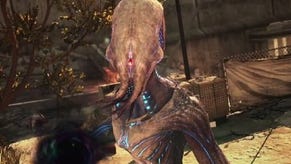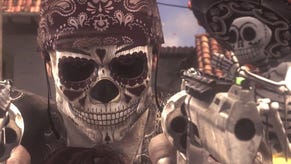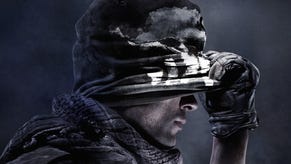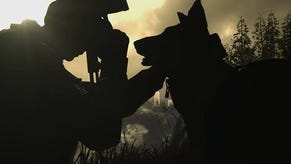Mocapped dogs, exponential polygons and a mysterious apocalypse: Infinity Ward's next-gen Call of Duty: Ghosts
Muzzle flash.
The next-gen version of Call of Duty: Ghosts, the first game in the blockbuster shooter series to appear on the PlayStation 4 and next Xbox, has perfectly round weapon sights to go along with its ear-splitting explosions and relentless Michael Bay action.
It also has a motion-captured dog squad mate who sniffs out explosives and protects the Ghosts, a fictional team of soldiers who in Infinity Ward's new near future Call of Duty universe are America's great hope in the battle against a new superpower that emerged after some mysterious apocalyptic world event.
Oh, and the dog has scars on his nose and a tattoo on his ear.
This is all made possible by Ghost's next-gen engine, which powers new tech Infinity Ward's executive producer Mark Rubin showed off during a recent event in Santa Monica, California. Ghosts is the first next-gen Call of Duty game from the creator of the series, and it's clear Infinity Ward wants to highlight the hard work it's done making the jump to next-gen an obvious - and substantial - one.
Let's start with Sub-D, an advanced graphics tech that has been planted into Infinity Ward's engine to improve the fidelity of the game's visuals. It does this by increasing the number of polygons - the triangles that make up a game's geometry - in real-time as players get closer and further away from objects.
The example used is a weapon sight. In 2011's Modern Warfare 3, when you looked closely at the sight of your weapon, you might have noticed it appear jagged. With Sub-D on, the number of polygons that make up the circular sight is dramatically increased so it appears perfectly round.
Sub-D extends to all facets of the game, including level environments and character helmets, and is married to the higher resolution textures possible with the increased power of the next-gen consoles. All of any given weapon is modelled, including the texture on the grip, the wires and even the screws. Previously in-level flat surfaces now have actual geometry.
Your character's arms, which in first-person shooters is the most-seen part of your character's body, have fine hairs, bruising, cuts and even dirt beneath the finger nails. Sub-D means the previously block hands are now smooth and curved. Environments benefit from new HDR (high-dynamic-range) lighting, self-casting shadows and tessellation. In a jungle level lifted from the game, there's a cave set behind a small waterfall. Move inside and you'll see steam and mist effects.
"The truth is, if you ask anybody who knows, there's no engine. There are pieces. There are engines. It's actually plural. There are parts of it that are completely new."
Infinity Ward executive producer Mark Rubin
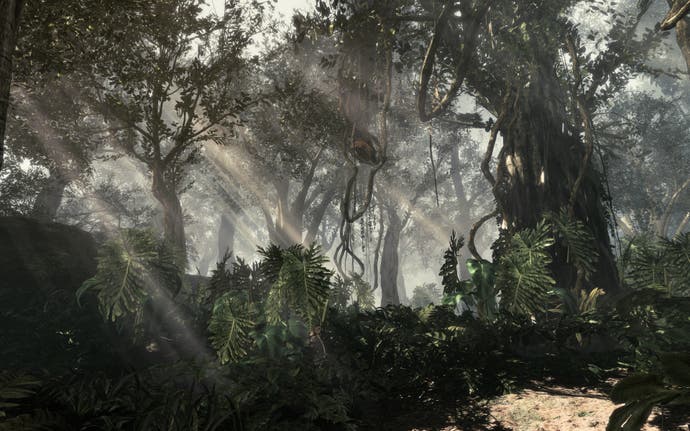
It's easy to get embroiled in the semantics of Ghosts' "new next-gen engine". Infinity Ward has never been big on the specifics of its tech, so its decision to delve deep into into its new threads is a somewhat surprising one. But I can't help but feel that describing it as entirely new is overselling it a tad.
"We never really got into naming, or trying to call ourselves out as a tech engine," Rubin tells me in a follow-up interview.
"All advanced tessellation is new for the engine. The HDR Lighting is new. It's just a complicated thing. I guess part of the problem is, we don't name our engine. We won't name our engine. We don't try to sell our engine to anybody else. We don't want to focus in on the engine too much.
"The truth is, if you ask anybody who knows, there's no engine. There are pieces. There are engines. It's actually plural. There are parts of it that are completely new. The lighting is completely new. There's a lot of it that is so completely new.
"We're getting pulled by what we want to achieve with this game, and we're getting pulled by the fact we now have these next-gen consoles to consider. Where that was going to put us on a chess board, what pieces were getting moved, became a very complicated thing in our development."
I push Rubin on specifics: what's new, exactly? "It's a really tough thing to answer because I guess I would say it's more complicated than a simple answer."
So some parts are new and some parts are an iteration on previous work used for Modern Warfare 3?
"The answer is yes to everything. We're not the kind of people who care about engines. We're not the kind of people who tout engine or name engines even. So for us to say it's a new engine is pretty strong. But I think if you ask anybody any engine you know out there, from version three to some other version, it's just an iteration."
One of the reasons gamers love Call of Duty - perhaps the chief reason - is its silky smooth 60 frames per second visuals and low latency controls. Ghosts will maintain this across all platforms, from current-gen to next-gen and, of course, PC. But what about resolution? On PlayStation 3 and Xbox 360 the game runs at 720p while maintaining 60fps, as with previous games in the series. What about on PlayStation 4 and the next Xbox?
"This is very political because there's a lot about the consoles I can't talk about," Rubin says, laughing. "But we will be whatever the consoles are going to run at natively."
For Infinity Ward, the point of all this admittedly impressive fancy new tech is to increase the realism of Call of Duty's graphics, which, in turn, the studio hopes, will help you, the player, feel more involved and attached to the game world. But what is a game world without a story?
Ghosts is set 10 to 15 years from now, when some kind of catastrophe cripples America. Its military forces are devastated, its government is in disarray. A new superpower has emerged. What this is Infinity Ward won't say.
Is it Belgium?
"No that would never happen," Rubin replies.
Ireland?
"Also would never happen. Not believable."
"In previous Call of Dutys you were the badass. Now you're fighting against the guys with all the tech and superior technology and forces."

Ghosts' world rekindles memories of THQ and Kaos' ill-fated 2011 shooter Homefront, which, somewhat ironically, was created to take on Activision's gargantuan franchise at its own game. It's not post-apocalyptic, more apocalyptic, Rubin says. The game begins with a prologue that reveals this mass event experienced by two brothers first hand. Act one picks up with these characters 10 to 15 years later. They've grown up in this new world as a part of their lives. It's an idea concocted by Stephen Gaghan, who won an Oscar for penning the script to Steven Soderbergh's film Traffic.
"The great thing about that is now we get to have this world where things have changed from a status quo standpoint," Rubin says. "The United States and the West aren't the superpowers they used to be. Things have flipped around. The US is now an underdog and a resistance force constantly under attack and barely holding on and barely surviving. And there's someone else, which we're not talking about at the moment, who is the new superpower - someone who wasn't a superpower before."
He continues: "And it doesn't really matter who, honestly, because it's that switch. In previous Call of Dutys you were the badass. You were the super army soldier guy who had all the resources behind you. You had tonnes of tanks and planes and hi-tech gear. You were always the top alpha dog of the world. Now you're not and you're fighting against the guys with all the tech and superior technology and forces.
"We felt that was a really strong start point for what our story gameplay would be like. It allowed us to rethink some of the gameplay the player's going to experience."
"It's not going to feel futurey. It's going to feel very grounded and it's going to feel very today. But I'm not even sure that rings true since the world you're going to be in is so different."
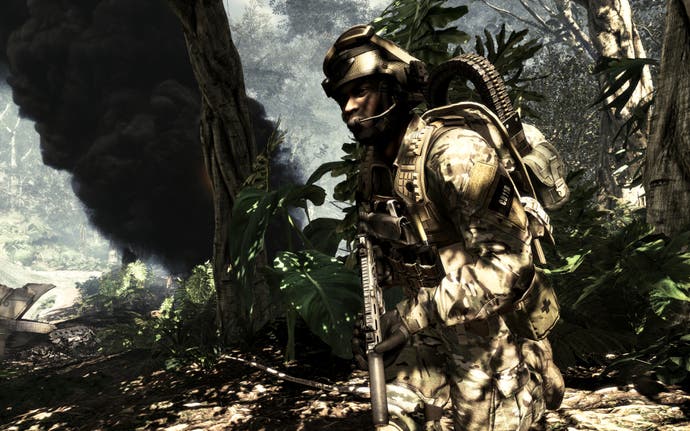
The Ghosts are a team of Special Forces modelled on Navy SEAL Team Six, the real-life group of soldiers who took down Osama Bin Laden. In this fictional apocalyptic world their actions give the US hope, but they face an uphill struggle. The Ghosts have access to today's weaponry, but given the game is set 10 to 15 years in the future, the enemy, this new mysterious superpower, has access to more advanced tech than they're troublesome opponents.
So while we're not talking about mech suits or anything, it's clear the player, who assumes the role of one of the two brothers throughout the game, will be at a disadvantage. "If anything we've gone backwards," Rubin explains, "and we're using what we have now as precious, priceless resources that we're very limited on, and don't have these mass factories pushing out cool new tanks.
"The other guys have some new cool tech and new stuff, but you're fighting against them, not with that. So it's not going to feel futurey. It's going to feel very grounded and it's going to feel very today. But I'm not even sure that rings true since the world you're going to be in is so different now."
With Activision's PR campaign for Ghosts in its infancy, much is being held back. Information on actual new gameplay mechanics is limited. Rubin mentions in passing that there's a new mantle system which means players who sprint into a wall will leap over it while maintaining momentum, there's a new lean feature for poking in and out of cover, and a dramatic slide for getting out of the line of fire quickly.
As for multiplayer - for millions the only reason to play Call of Duty - expect new, dynamic maps.
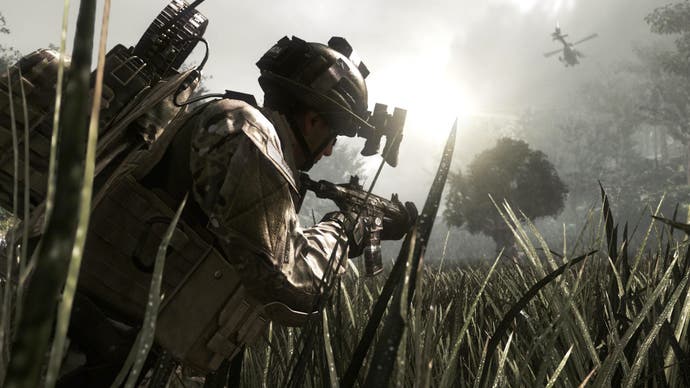
As for multiplayer - for millions the only reason to play Call of Duty - expect new, dynamic maps. Map-changing events, from earthquakes and floods to player-driven actions, should add a touch of the unpredictable to proceedings. Explosive traps, for example, will change the flow of the map, Rubin says, and players will face gameplay mechanics that must be worked with to win. Elsewhere, character customisation, which lets you alter your soldier's head, body, helmet and gear, should add a sense of individuality to your play.
I expect that for all Ghosts' new next-gen tech Call of Duty fans will find it instantly familiar. There can be no doubt that ditching the powerful Modern Warfare brand and embarking on a new universe is a risk, but we're not talking about a jump into space or the end of red dot sights here. This is Call of Duty. At the end of the day you'll be shooting bad guys, left reeling by explosive set-pieces in single-player and fussing over your kill/death ratio in multiplayer.
A 10 minute gameplay demo of an underwater level is so very Call of Duty (for some reason Activision likes to reveal Call of Duty with water levels - an inside joke?). The player and squad mate are swimming just below the surface, sneaking about, trying to avoid enemies. Shoals of fish and stealth kills via what must be a gas powered gun are sandwiched by deadly sonar pulses. Then, in typical Call of Duty fashion, all hell breaks loose. Metal slams into the water from above as the player swims to safety, shooting and dodging. Noise, (underwater) explosions and dramatic endings have stood Call of Duty in good stead over the years, and it's clear Ghosts will give the fans what they expect.
Noise, (underwater) explosions and dramatic endings have stood Call of Duty in good stead over the years, and it's clear Ghosts will give the fans what they expect.
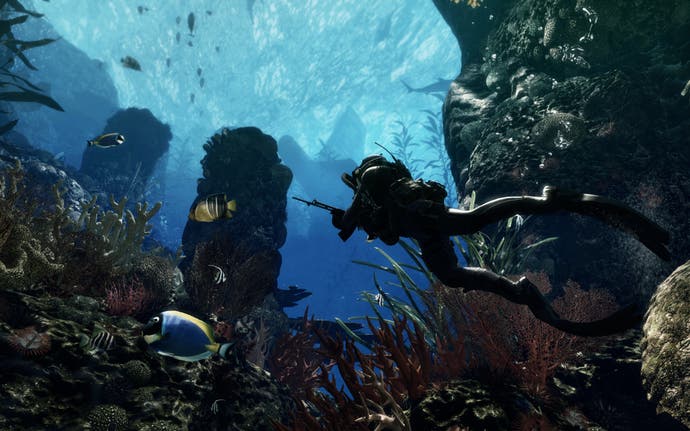
"It occurred to us early on that we were now in this opportune moment where we're going to be on next-gen - and that came to us slowly but surely as the first parties started revealing they were going to do next-gen," Rubin says. "And then it also came around that this might be a good opportunity to do a new story. Not just a new story but a new story in a new universe.
"You put all those pieces together and you go, hold on a second, we're the studio that created Call of Duty and we're the studio that brought Call of Duty to the last generation of consoles. We get this opportunity to do that again, and we get the opportunity to do it in a whole new world, a whole new story, a whole new setting, all new characters, and do it on a whole new engine. This was perfectly laid out in front of us. We had to be a part of that."
Yes, yes, that's all very good, but what about this German Shepherd? As I'm ushered out of the trailer in which I'm interviewing Rubin, I can't help but wonder: what's the dog's name? Rover? Colin? Fido? Can I give him a name? Can I order him about with the push of a button, or perhaps by barking an order into Kinect 2.0? Wait, how about this: I name him Colin (we gave our dog a bad name), Kinect 2.0 recognises when I say the word and, when I do, the in-game dog listens to my command. Can I shout: "Colin! Tear that chap's testicles off!" then sit back and admire the view?
"We had a great experience working with the dog," is all Rubin will say, pointing to E3. "It was really fun. Early on we thought it would be cool to have a dog, but we didn't really understand it. We brought in a Navy SEAL with his dog and the stuff he told us emotionally and technically about that dog was just absolutely amazing. He said he would take a bullet for his dog. That's how attached those dogs are to their squads. So, the dog is really amazing."
Will we fall in love with Call of Duty: Ghosts' dog? Dare we ask that question in the post-Fable world? Will I take a bullet for my dog? Perhaps, during Ghosts' climactic final scene, when, finally, the mysterious new superpower is near defeat, I'll be faced with this moral conundrum: do I save my dog, or the world?
Despite the world's tessellation and Sub-D and HDR Lighting, right now, I'm going with the dog.
"He said he would take a bullet for his dog. That's how attached those dogs are to their squads."











